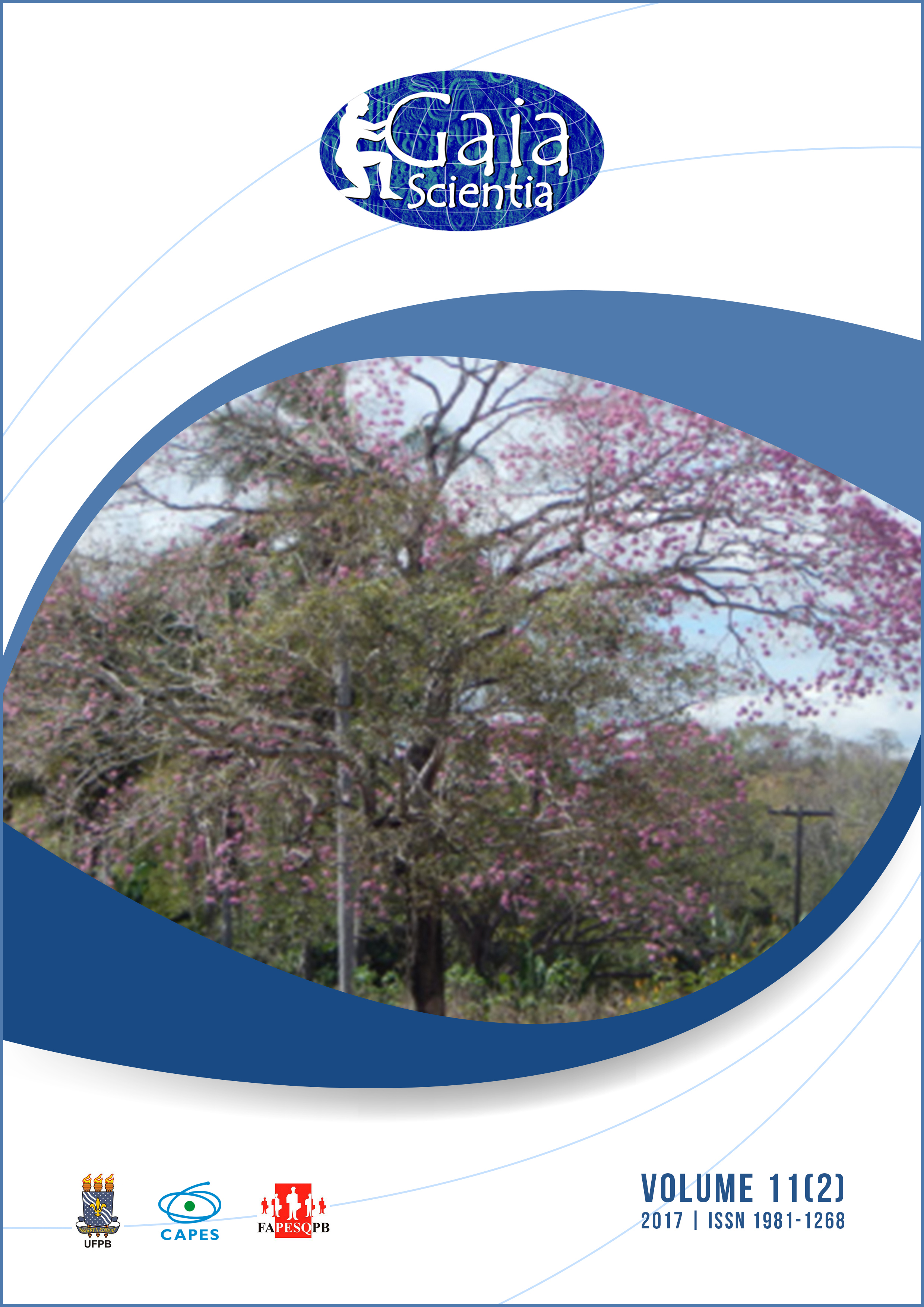Determination and application of drought vulnerability index in the semi-arid region of Brazil
DOI:
https://doi.org/10.22478/ufpb.1981-1268.2017v11n2.31778Resumo
The Northeast of Brazil has been affected, since the beginning of its colonization, by the droughts. However, most of the studies on drought phenomenon usually deal with physical aspects, such as its severity, extension, and periodicity, neglecting other aspects of the region such as its social, economic, cultural, and production characteristics. Considering how important it is to analyze these factors to gethering studies that investigate the vulnerabilities in the Brazilian semiarid region, this study aimed to evaluate the vulnerability to drought in the municipalities of Picuí, Sumé, and Sousa in Paraíba State, Northeast of Brazil. It was performedby adapting the vulnerability index proposed by Bhattacharya and Dass (2007), which calculates the exposure, sensitivity and adaptive capability factors based on data of the municipalities, mainly those from 2010. The results obtained in this study shows that the municipality of Picuí had the highest exposure (index of 0.390), and the worst performance in sensitivity (index of 0.251). Regarding the indicator of Adaptive Capability, Sumé stood out in a negative way, with an index of 0.315. In general terms, Picuí presented the highest Vulnerability Index (0.346), followed by Sumé (0.297) and Sousa (0.287). The Vulnerability Index proved to be an adequate instrument to develop a holistic study on risk management of social and environmental disasters, and it could be used by managers and decision makers to develop public policies and to create preparation and coexistence local plans to mitigate the problems caused by the drought.
Downloads
Referências
Antwi-Agyei, P., et al., 2012. Mapping the vulnerability of crop production to drought in Ghana using rainfall, yield and socioeconomic data. Applied Geography Volume 32, Issue 2, Pages 324–334.
Babaei, H., Araghinejad, S., Hoorfar, A. 2012. Developing a new method for spatial assessment of drought vulnerability (case study: Zayandeh-Rood river basin in Iran). IN: Water and Environment Journal. doi: 10.1111/j.1747-6593.2012.00326.
Bhattacharya S., e Dass A.. 2007. Vulnerability to drought, cyclones and floods in India. Winrock International, India.
BRASIL, 2005.. Nova delimitação do Semi-árido brasileiro. Brasília, DF.
Briguglio, L., 2003. The vulnerability index and small island developing states: areview of conceptual and methodological issues. In: AIMS Regional Preparatory Meeting on the Ten Year Review of the Barbados Programme ofAction, Praia, Cape Verde.
CPRM, 2005a. Serviço Geológico do Brasil - Projeto cadastro de fontes de abastecimento por água subterrânea. Diagnóstico do município de Picuí, estado da Paraíba. Recife: CPRM/PRODEEM, 2005a.
CPRM, 2005b. Serviço Geológico do Brasil - Projeto cadastro de fontes de abastecimento por água subterrânea. Diagnóstico do município de Sousa, estado da Paraíba. Recife: CPRM/PRODEEM,
CPRM, 2005c. Serviço Geológico do Brasil - Projeto cadastro de fontes de abastecimento por água subterrânea. Diagnóstico do município de Sumé, estado da Paraíba. Recife: CPRM/PRODEEM.
Feitosa P. H. C. et al. 2010.Estudo comparativo das vulnerabilidades no cenário seca/desertificação em municípios do semiárido brasileiro e norte de Portugal. IN :Revista verde de agroecologia e desenvolvimento sustentável. Mossoró – RN – Brasil, V.5, N.3, P. 01 – 09.
Hebb, A., Mortsch, L., 2007. Floods: Mapping Vulnerability in the Upper Thames Watershed Under a Changing Climate. Project Report XI. University ofWaterloo1–53.
Hoekstra, A. Y.; Hung, P. Q. 2002.Virtual Water Trade: A quantification of virtual water flows between nations in relation to international crop trade. Value of water research report series, Netherland: UNESCO/IHE, n. 11, p. 25-47.
Kei, 2005. State of the Art Report on Simulation and Indicators, Knowledge Economy Indicators, Work Package 7, https://www.uni-trier.de/fileadmin/fb4/projekte/SurveyStatisticsNet/KEI-WP7-D7.1.pdf.
Kumara Suresh, Raizada, A., Biswas, H., Srinivas, S., Mondal, Biswajit. 2016. Application of indicators for identifying climate change vulnerable areas in semi-arid regions of India. Ecological Indicators, 70, 507–517.
Mccarthy, J.J., O.F. Canziani, N.A. Leary, D.J. Dokken, K., White S. (eds.), 2001. Climate Change: Impacts, Adaptation and Vulnerability. Contribution of Working Group II to the Third Assessment Report of the Intergovernmental Panel on Climate Change, Cambridge University Press, Cambridge, UK, x+1032 pp.
OECD. 1993. Draft Synthesis Report, Group on State of the environment Workshops on Indicators for Use in Environmental Performance Reviews. Doc ENV/EPOC/SE. Organisation for Economic Co-operation and Development, Paris,.
OECD. Environmental indicators: OECD 1994.Core Set. Organisation for Economic Co-operation and Development, Paris.
Rosendo, Eliamin E. Q., 2014. Desenvolvimento de indicadores de vulnerabilidade à seca na região semiárida brasileira. Dissertação (Mestrado), UFPB/CT. João Pessoa, Paraíba, Brasil.
Safi, A. S., Smith W. J., Liu Z., 2012. Rural Nevada and climate change: vulnerability, beliefs, and risk perception. Risk Analysis, Vol. 32, No. 6, 2012. DOI: 10.1111/j.1539-6924.2012.01836.x
Salvati, L., Zitti, M., Ceccarelli, T., Perini, L, 2009. Developing a synthetic index of land vulnerability to drought and desertification. Geographical Research, volume 47, Issue 3, pages 280–291, September 2009, DOI: 10.1111/j.1745-5871.2009.00590.x.
Silva, R. M. A., 2006. Entre o combate a seca e a convivência com o semi-árido: transições paradigmáticas e sustentabilidade do desenvolvimento. (Tese de Doutorado). Brasília: UNB, 298p.
UNESCO, 1977. Conferência das nações unidas sobre a desertificação. Nairobi.










